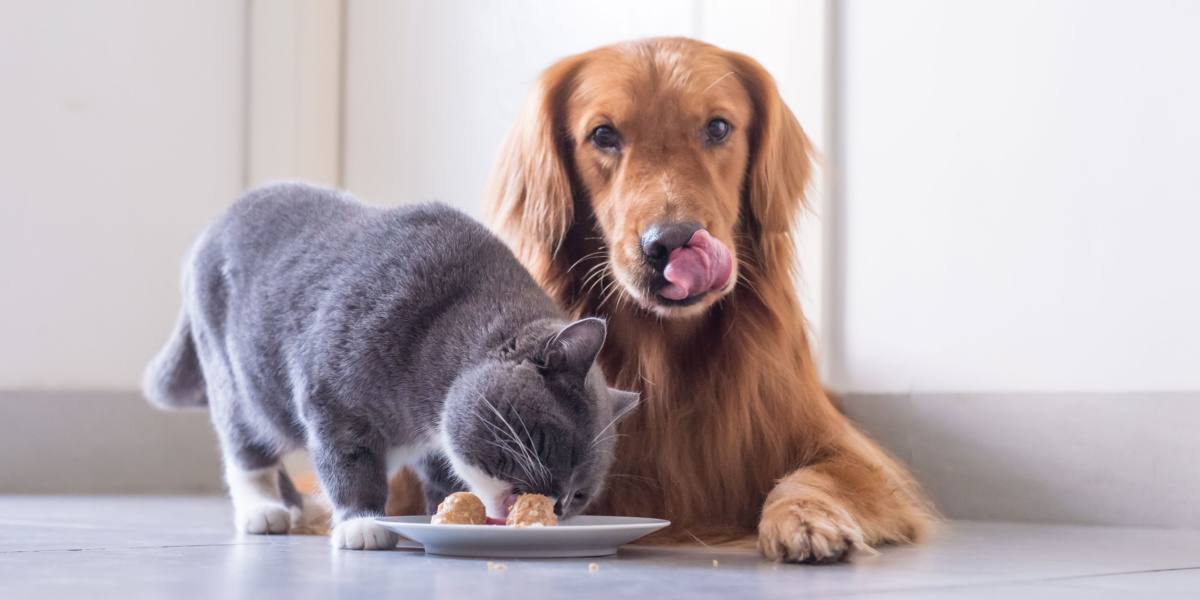
Pet owners who live with both feline and canine companions will surely be used to a little chaos in their lives, alongside lots of love, companionship, and cuddles.
Although having multiple pets can be a lot of fun, some aspects of dog behavior can make the practicalities a little tricky. If your dog eats your cat’s food, it can be really difficult to know how to stop this behavior, especially if your cat is used to free feeding.
Dogs eating cat food is a common problem in multi-pet households, but this is not advisable for their health and well-being. Various solutions exist, including separate feeding times and restricting access to the cat's food using baby gates, door straps, or feeding stations. Other methods to try include placing your cat’s food somewhere high that dogs cannot reach or using puzzle feeders or dog-proof bowls.Key Takeaways
Never fear, we have some great tips to keep your pooch eating their own food. From feeding stations to following a strict routine, read on for 10 practical solutions.
Can Dogs Eat Cat Food?
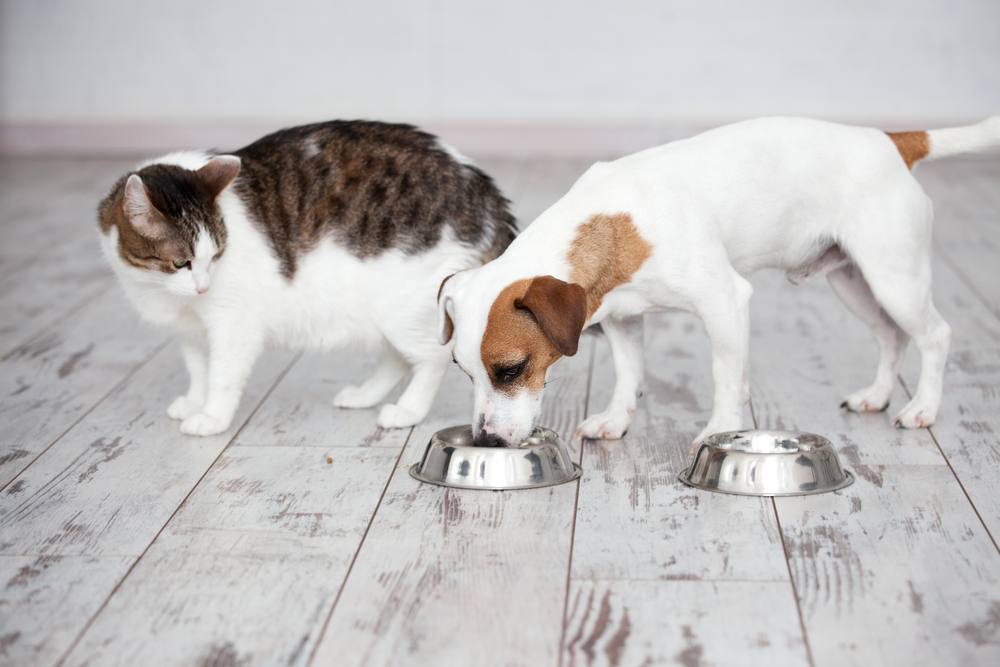
It’s unhealthy for dogs to eat cat food as dogs and cats have different nutritional needs.
First, is it even a problem if your dog is ignoring their dog food in favor of the cat’s kibble? It’s all just pet food, right? No! Cats and dogs have very different nutritional needs. As pet parents, it is one of our key responsibilities to ensure our pets are provided with a suitable, nutritionally complete diet.
Cats are obligate carnivores, so cat food is highly protein-based, with lower levels of carbohydrates. Cats also need supplemental amino acids, which they cannot make internally, such as taurine. It is not healthy for dogs to eat cat food, either wet food or dry.
A one-off incident might cause no problems, or perhaps just a mild upset stomach, but eating cat food long-term can be problematic for dogs. Various health issues might arise, such as nutritional deficiencies and weight gain.
Here are our 10 tips to keep your dog out of the cat food.
1. Strict Mealtimes
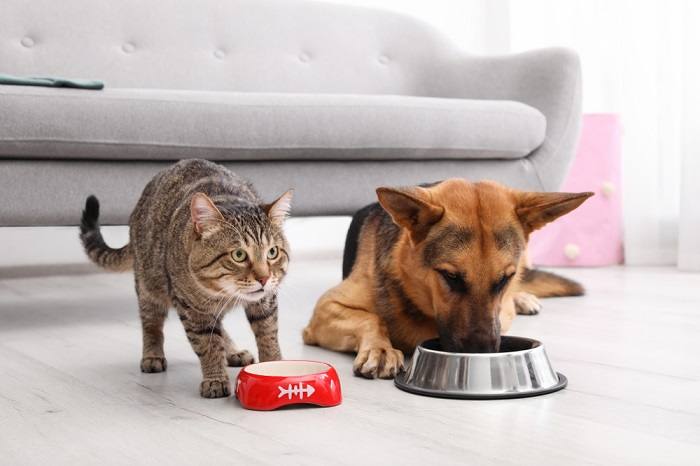
Monitor mealtimes to make sure that each pet is eating only their own food.
If your dog is stealing cat food behind your back, one way to counter this is to feed your cat at specific meal times and take the dog out of the room for these sessions. This method works best for cats that are happy to eat their food as soon as it is given to them, rather than grazers who prefer ad-lib access. However, this is quite time-demanding to owners.
If you don’t want to take your dog out of the room, sit there to monitor feeding time. Cats often eat well with some company, and you can make sure the right animal eats the right food, with no interruptions.
Also Read: How To Get A Dog And Cat To Bond
2. Synchronize Hunger
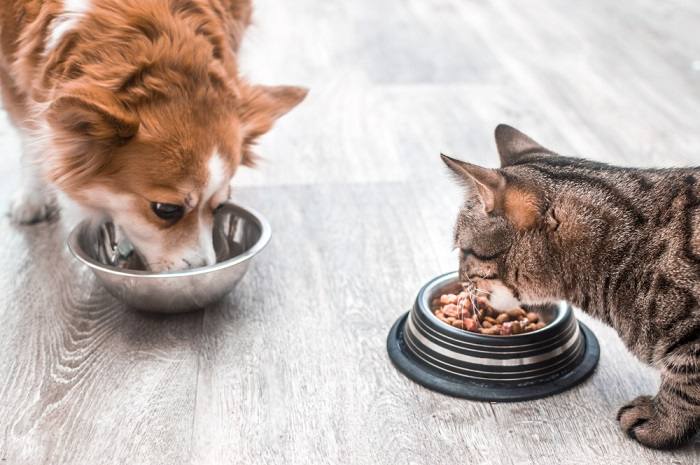
Feeding your dog first or at the same time ensures a full tummy, which might lead to less food stealing.
Is your pooch stealing the cat food because they are hungry? Try feeding your dog at the same time as the cat, or feed your dog just before feeding your cat. This way, your dog will have a full, satisfied tummy when the cat food is around, and will be less motivated to eat it.
By the time they’re hungry again, hopefully, the cat food will have disappeared into the right animal! This won’t work for all dogs (greedy Labradors, I’m looking at you!), but it’s worth ruling out hunger as a factor.
Also Read: Why Does My Cat Beg For Food?
3. A Cat Door
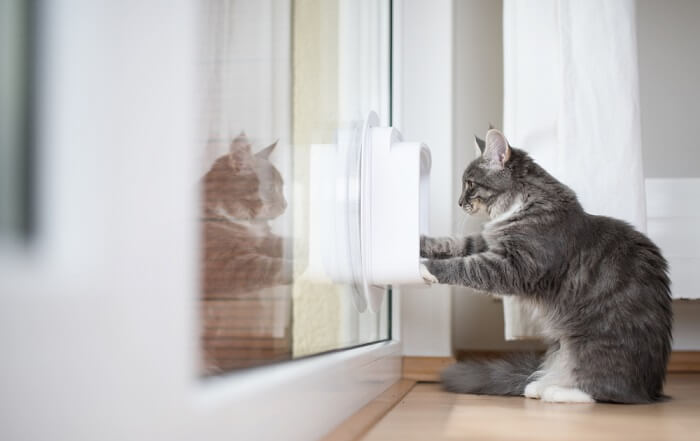
Consider providing a dog-free space for your cat where their food is accessible to them.
Stopping the dog from eating the wrong food might mean having the food somewhere that the dog can’t access. If you have the space, you can designate a room to be “dog-free” by using a cat door.
The cat food can be then left down all day in this room (useful for those cats that like to pick at dry food left down all day), and they can come and go as they please, using the cat flap, whereas it is inaccessible to the dog. Small dogs can fit through a cat door, but microchip-activated cat flaps are available.
Also Read: How To Train Your Cat To Use A Pet Door
4. Dog-Proof Gate

Pet gates are great for separating dogs and cats since many cats can easily squeeze through the openings.
Another option for restricting access to forbidden food is to use a gate that is dog-proof but allows a cat through. There are specially designed gates for this, but a baby gate is another option. Again, this allows cats to graze on their food without it being stolen from them. This works best with a small cat and a large dog and can be more difficult if a small dog is the culprit.
5. A Door Strap
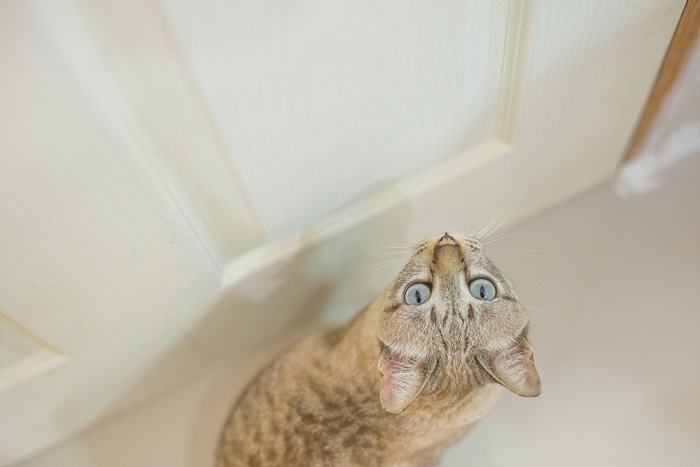
Door straps keep doors slight ajar so flexible cats can squeeze through but not larger dogs.
An alternative to a gate is a door strap. This is a fairly simple contraption available online that can “lock” a door while allowing it to be slightly ajar—enough for a cat to sneak through but not a dog. The cat food can then be placed behind this door, out of reach of a canine mouth.
This is another method that works better against large dogs, but they are adjustable so as long as the cat is smaller than the dog, it should work. Cats are super flexible and able to squeeze through small gaps, so it can work better than you think even if your dog isn’t much bigger than the cat.
6. Elevate The Food Bowl
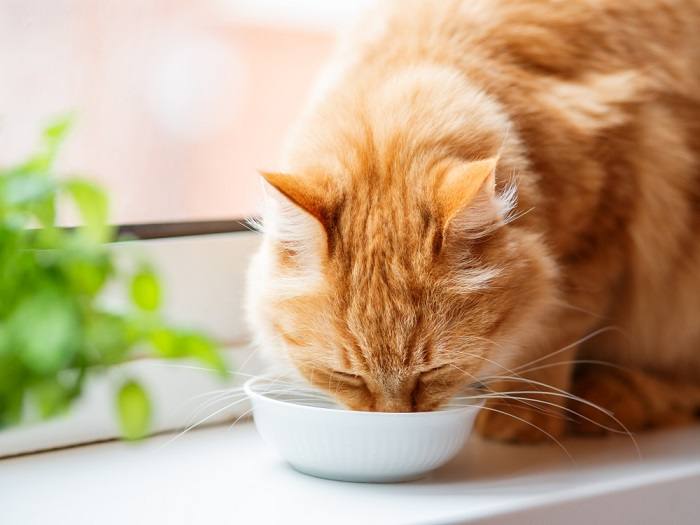
Cats enjoy eating their meal with a view, and placing the food up high means dogs can’t reach it.
The third option for keeping cat food away from dogs is a simple one: place the cat food bowl somewhere up high. This one is great to curtail small dog thieves that cannot reach up onto a cat tree or kitchen countertop.
Cats are generally excellent at jumping and climbing, and often actively prefer to be up high with a good view of their surroundings. Elderly cats and those with joint conditions such as arthritis, however, might find this more difficult.
Also Read: The 5 Best Elevated Cat Bowls
7. Cat Feeding Station

Cat feeders are great for making sure each pet gets their own food.
If you cannot separate the dog from the cat food, there are ways to contain the food so that only your cat can get to it. A feeding station is an excellent choice for busy households with multiple pets.
There are different types of cat feeders, some with timer functions, or a microchip sensor (microchip pet feeders), which will only dispense food to the correct animal when it registers their chip.
This won’t prevent your dog from grazing on leftovers, but it can be a good choice for cats who like to eat small meals often—you can set the feeder to only dispense set amounts of kibble at a time.
Cat feeders are also really useful for vacations, cats that eat during the night or unpredictably, and for those tricky situations where one cat in a multi-pet household needs a special food or is on a restricted diet.
8. Puzzle Feeder
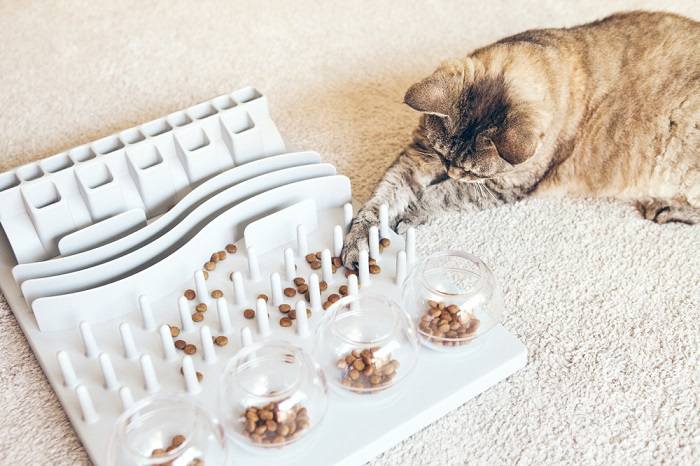
Dogs might be unable to extract food from a cat puzzle feeder.
If you cannot separate your pets, another option you can try is a puzzle feeder. These are wonderful for cats anyway, as they provide both physical and mental stimulation in order for your cat to be fed, mimicking how they would eat in the wild. They can reduce obesity and add enrichment to cats prone to boredom. It’s also a cunning way to keep greedy pooches out of your cat’s food!
Also Read: The 10 Best Cat Slow Feeders & Puzzle Feeders
9. Protective Cat Bowl
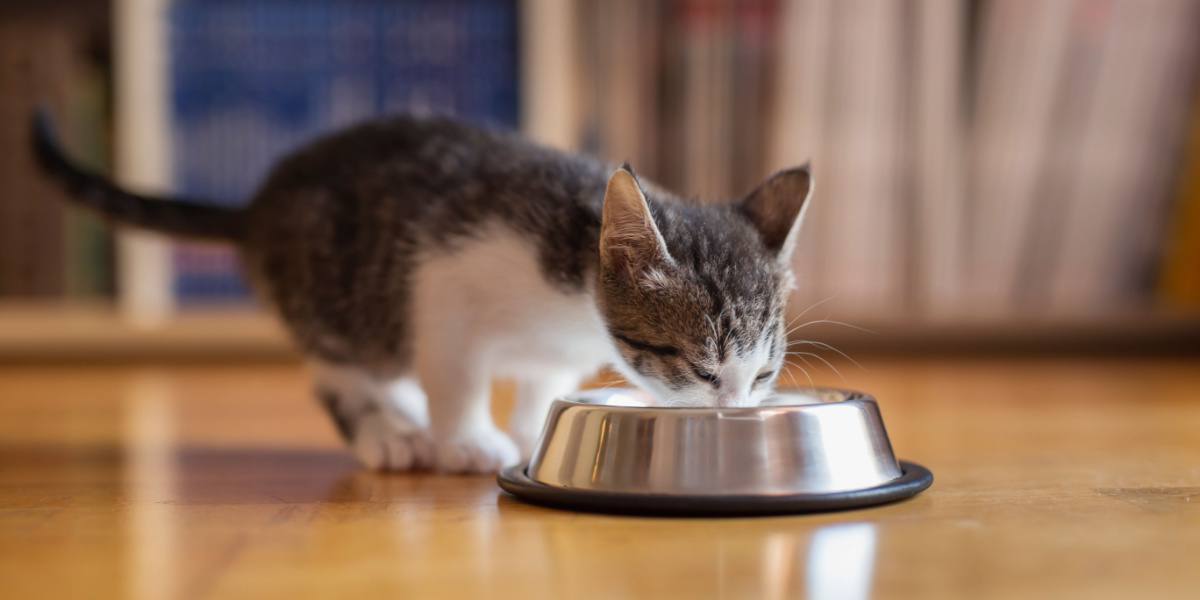
Some bowls have special openings that make it hard for a larger dog to reach the food.
A dog stealing the cat’s food is a common problem, so there are some cat food bowls that have been specifically designed to keep dogs away. These feed dishes are usually designed with a small opening to feed through, suitably sized for cats and not dogs, or a cover made to keep dogs away.
Some cats don’t like their whiskers to be touching the bowl as they eat, which makes these bowls less appealing to them, but many cats will be perfectly happy. It’s worth a try!
10. Enrichment
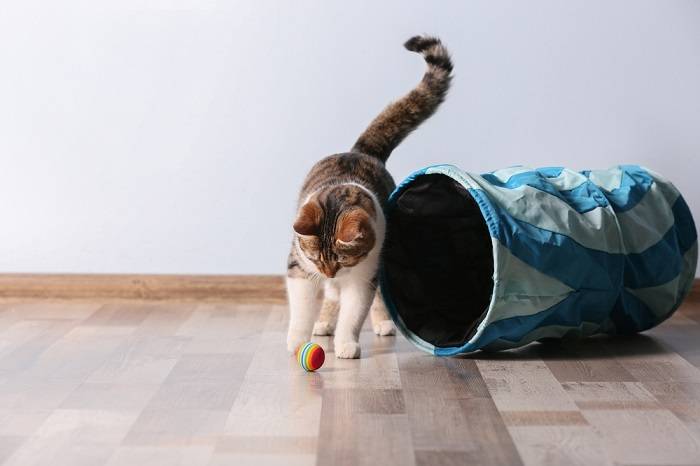
As with cats, making your dog’s life interesting might cut down on snacking due to boredom.
Lastly, consider that your dog may be stealing the cat’s food out of boredom rather than hunger. Try adding in some enrichment, such as chews, toys, and interactive games, and see if their behavior settles as a result. Lots of active play, exercise, and a good diet might help your dog snooze when they are left alone, rather than get into mischief.
Dog training can also be utilized to teach your pooch that the cat food is off-limits—practice the “leave” command with plenty of positive rewards and treats when they manage it.
Also Read: The 10 Best Chew Toys for Cats
Final Thoughts
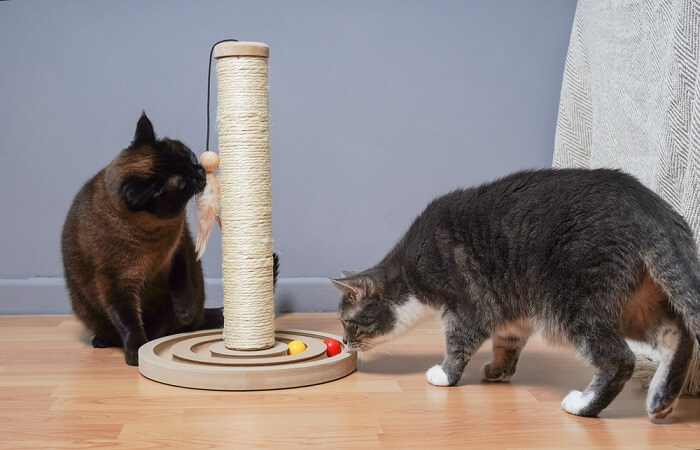
Ensuring your cat eats cat food and your dog eats dog food means all of your pets will be healthy and satisfied.
Dogs and cats are physiologically very different and require individual diets. There are a variety of ways to prevent your dog from eating cat food. You might need to try a few of these methods to see what works best for you and your pets or even use a combination of techniques. Good luck!
Also Read: 6 Surprising Similarities Between Cats And Dogs
Frequently Asked Questions
How do I get my dog to stop eating cat food?
Stop dogs from eating cat food by restricting access to the food by using a door strap, baby gate, or physically shutting them away while the cat eats. Elevated cat bowls, feeding stations, puzzle feeders, or dog-proof bowls are other options, alongside good training.
Why does my dog keep eating cat food?
Cat food is high in protein and often very "meaty" flavored, which can attract dogs. They might be genuinely hungry, or just in need of entertainment.
How do you keep dogs and cats from eating each other's food?
Dogs and cats have different nutritional needs and should eat their own food. Separate feeding times, restrict access to other bowls using baby gates, door straps, or feeding stations and keep your cat’s food somewhere high that dogs cannot reach.




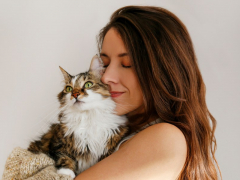



None of these suggestions will work. My cat is 10 and a little arthritic, so high is out, I have a disabled son, so baby gate us out. My cat eats most of his food in the middle of the night, so different feeding times don’t work. I cannot put the cats food I’m any of the bedrooms. The puppy will just climb on an elevated feeding station.
So – what do I do?
Hi Joyce,
You could something like try feeding your cat in a large crate or playpen with an opening small enough for the cat but not the puppy. Another option is using a microchip-activated feeder that only opens for your cat. If your cat prefers eating at night, you might also try feeding in a covered area the puppy can’t access, like under a sturdy table or behind furniture.
My current dog, unlike his predecessors loves cat food. My cats dry food is under an unused rocker so she can free feed and the dog can’t reach. For her wet food I try to put it on the dryer where she can jump but he can’t reach.. As she is getting older I will put her wet food on the floor but have to stand guard while she eats. The dog has it figured so each time ge goes out he will immediately head to the laundry room to see if any food is left. He has even stopped in the middle of his to seek hers, then return to finish his. Pets are wonderful.